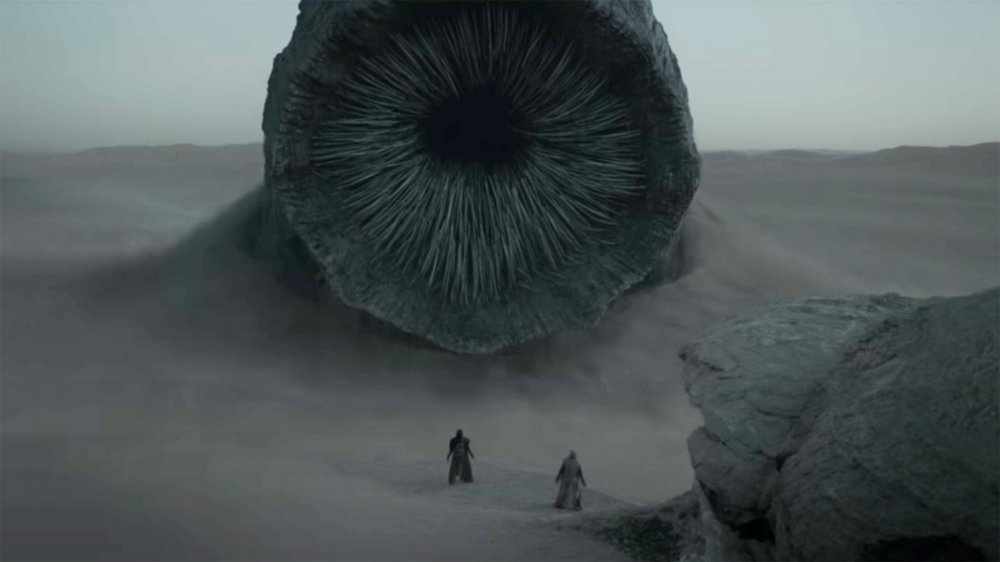The Real Meaning Behind The Sandworms In Dune
Denis Villeneuve has finally unleashed the first full-length trailer for his forthcoming sci-fi epic, Dune, on the world, and with it the world got a terrifying glimpse of the fabled Arrakis sandworm. The new trailer actually provided a ton of first glimpses, but that sandworm overshadows all of them — both literally and figuratively.
In the final minutes of the trailer, we see Paul Atreides (Timothée Chalamet) and his mother (Rebecca Ferguson) running from a disturbance in the Arrakis desert. Is it drum sand? A Harkonnen horde? Far worse. As Paul recites the Bene Gesserit Litany Against Fear, a massive sandworm, toothy maw agape, arises to loom over the fearful Atreides. Aside from the sheer immensity of the sandworm, it's notable that Villeneuve decided to give this first image of Shai-Hulud such a prominent place at the climax of the first trailer for his eagerly anticipated film — notable, though not exactly surprising.
The sandworms are one of the most fascinating and enduring elements adapted from Frank Herbert's original work. Fans have been waiting to see the Worms — not just because they're awesome — but because they're central to the sprawling story of Dune, originally told over six novels by Herbert and completed over two more by his son Brian and sci-fi author Kevin J. Anderson. The sandworms of Arrakis continue to haunt our imaginations because they are so much more than just a menacing MacGuffin — they're the very reason the Atreides saga even exists.
The spice must flow
If you know anything about Dune, you probably know that the hottest commodity in the Duneverse is a psychoactive substance known as the "spice melange" — or, simply, "spice." Aside from lighting its users up with radical blue eyes, the spice expands the minds of its users in miraculous ways and facilitates interstellar travel. Since its near-magical effects can't be artificially reproduced, it's become the backbone of the entire galactic economy. Whoever controls the spice controls the galaxy, and the spice is only found on one world: the hostile desert planet of Arrakis.
Why can't the spice simply be domesticated and cultivated on other worlds, you ask? Excellent question. Melange is not a plant product like most mundane spices, but rather a biological byproduct of the sandworm's life cycle. Over their epochal lifespan, the sandworms of Arrakis grow from tiny "sandtrout" to the massive Old Men of the Desert like the one you see in the last frames of Villeneuve's first trailer. As they molt and expand, they excrete large caches of melange beneath the desert sands. These spice bulges eventually "burst" up to the surface, a process that signals Fremen prospectors to begin mining.
Given the importance of the spice, you might wonder why no one's attempted to transport a sandworm off of Arrakis. They have, but the worms are so hydrophobic that they die almost immediately after being lifted from the desert. Dune is the only planet that can sustain sandworm life, and so Dune remains the center of power in the galaxy.
The inciting incident for the story of Dune is a transition of power on Arrakis from House Harkonnen of Giedi Prime (the bad guys) to House Atreides of Caladan (the good guys). As Duke Leto Atreides (Oscar Issac) and his son Paul ascend to power on Arrakis, they take control of the planetary spice mining operation — a seriously plum job. If not for the sandworms of Arrakis, there would be no spice, and thus no conflict. The sandworms are at the center of it all.
The Golden Path
The sandworms of Dune have even more significance to the story as we move beyond the scope of the first novel. Herbert's Dune introduces us to the nomadic Fremen, a desert people who survive on Arrakis by huddling in underground "sietch" shelters and wearing stillsuits, which capture and retain any moisture expressed through breathing or perspiration. These Arrakis natives have built a religion around the sandworms (with a little help from the Bene Gesserit Missionaria Protectiva), which they refer to as Shai-Hulud. Here's where things get crazy — potential spoilers beyond, as a result.
After the Fremen recognize Paul Atreides as their messiah — or "mahdi" — they teach him the ways of the desert (which include sandworm riding) and begin dosing him with an exceptional quantity of spice. This spice awakens a latent ability of prophetic foresight in Paul, who is now known by the Fremen name "Muad'dib." This power of prophecy proves more bug than feature, and Paul becomes preoccupied with his desire to steer humanity down the Golden Path, a millennial course that results in the indefinite survival and prosperity of the species. Part of that Golden Path yields Paul and Chani's (Zendaya) two children, the twins Leto and Ghanima.
On his way to the throne of Arrakis, Leto II covers himself in larval sandworms which meld with his skin and alter his biology, transforming him into a grotesque human-sandworm hybrid that rules over Arrakis for 3,500 years with an iron — err — tail. That's right, the key to human survival is putting an actual sandworm tyrant in charge of the planet for four millennia. The fourth book in Frank Herbert's original series, entitled God Emperor of Dune, chronicles the final years of Leto II's reign, and takes place largely inside the titular God Emperor's head as his human ego slowly succumbs to the Worm.
Who knows if Villeneuve will get that deep into the Dune mythology, but after seeing that first trailer, it would definitely be interesting to watch him attempt to realize on screen the Tyrant Leto Atreides II in all his Wormy, homicidal glory.


